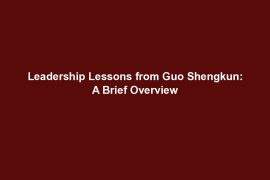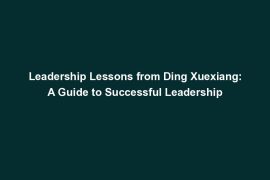Hey there, leadership enthusiasts! Today, we’re going to dive into the fascinating world of leadership with a focus on one of the most prominent leaders in the world – Li Keqiang. But first, let’s start with a quick overview of who Li Keqiang is and what makes his leadership style so intriguing.
Li Keqiang is a Chinese politician who currently serves as the Premier of the State Council of the People’s Republic of China. Known for his pragmatic approach and focus on economic reforms, Li Keqiang has been a key figure in shaping China’s development in recent years.
In today’s fast-paced and ever-changing world, effective leadership is more crucial than ever. Leaders need to be able to navigate complex challenges, inspire their teams, and drive forward progress. That’s why studying leaders like Li Keqiang can provide valuable insights into what makes a great leader tick.
Throughout this blog post, we’ll explore key leadership lessons that can be learned from Li Keqiang. From the importance of listening and understanding others’ perspectives to the value of transparency and open communication, we’ll uncover the traits and strategies that have made Li Keqiang a successful leader.
So, grab a cup of coffee, settle in, and get ready to discover how you can incorporate Li Keqiang’s leadership lessons into your own leadership style. Let’s dive in!
Leadership Lessons from Li Keqiang
Now that we’ve covered the background of Li Keqiang, let’s dive into the key leadership lessons that can be learned from his style. One of the most important aspects of effective leadership is the ability to listen and understand others’ perspectives. Li Keqiang exemplifies this by actively seeking out input from his team members and stakeholders before making decisions.
Another crucial lesson we can learn from Li Keqiang is the need for adaptability and flexibility in leadership. In today’s fast-paced world, leaders must be able to pivot quickly in response to changing circumstances. Li Keqiang’s ability to adjust his strategy in light of new information sets a great example for aspiring leaders.
Transparency and open communication are also key components of effective leadership. Li Keqiang is known for his willingness to share information with the public and maintain a dialogue with both internal and external stakeholders. This level of transparency fosters trust and collaboration, leading to better outcomes for all involved.
Lastly, let’s explore Li Keqiang’s approach to problem-solving and decision-making. He is known for his analytical thinking and pragmatic solutions to complex issues. By carefully weighing the pros and cons of different options, Li Keqiang is able to make sound decisions that benefit the greater good.
By taking these leadership lessons to heart, aspiring leaders can improve their own skills and become more effective in their roles. In the next section, we’ll discuss how you can apply Li Keqiang’s principles to your own leadership style and provide examples of other successful leaders who have done the same.
Applying Li Keqiang’s Leadership Lessons
Now that we have delved into the leadership lessons we can learn from Li Keqiang, let’s explore how we can apply these principles to our own leadership style.
Tips for Incorporating Li Keqiang’s Leadership Principles
One of the key takeaways from Li Keqiang’s leadership style is the importance of listening and understanding others’ perspectives. To apply this lesson, make an effort to actively listen to your team members, peers, and stakeholders. Take the time to understand their viewpoints and consider different perspectives before making decisions. By doing so, you can foster a more collaborative and inclusive work environment.
Another valuable lesson from Li Keqiang is the need for adaptability and flexibility in leadership. Be open to change, willing to pivot when necessary, and embrace new ideas and approaches. Flexibility is key in today’s rapidly evolving business landscape.
Examples of Successful Leaders
Several successful leaders have implemented similar strategies in their own leadership approach. Take, for example, Satya Nadella, CEO of Microsoft. Nadella is known for his focus on empathy, empowerment, and inclusivity, which aligns with Li Keqiang’s emphasis on understanding others’ perspectives and fostering collaboration.
Suggestions for Further Reading
If you’re interested in further developing your leadership skills, there are plenty of resources available to help you grow. Consider reading books such as Leaders Eat Last by Simon Sinek or Dare to Lead by Brené Brown. These books offer valuable insights into effective leadership practices and can inspire you to become a better leader.
Conclusion
In conclusion, by incorporating Li Keqiang’s leadership lessons into your own style, you can become a more effective and impactful leader. Remember to listen, adapt, communicate openly, and approach problem-solving with a strategic mindset. Continuous growth and improvement are essential in leadership roles, so never stop learning and evolving. By embracing these key principles, you can inspire and empower those around you, driving success and innovation in your organization.



